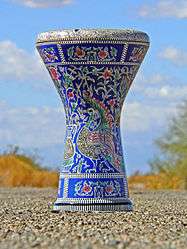Kissar
The kissar (also spelled kissir), or Gytarah barbaryeh, the ancient Nubian lyre, still in use in Egypt and Abyssinia. It consists of a body having instead of the traditional tortoise-shell back, a shallow, round bowl of wood, covered with a soundboard of sheepskin, in which are three small round sound-holes. The arms, set through the soundboard at points distant about the third of the diameter from the circumference, have the familiar fan shape. Five gut strings, knotted round the bar and raised from the soundboard by means of a bridge tailpiece similar to that in use on the modern guitar, are plucked by means of a plectrum by the right hand for the melody, while the left hand sometimes twangs some of the strings as a soft drone accompaniment.[1]
Notes
- ↑ Chisholm, 1911, p. 837.
References
-
 This article incorporates text from a publication now in the public domain: Chisholm, Hugh, ed. (1911). "Kissar". Encyclopædia Britannica. 15 (11th ed.). Cambridge University Press. p. 837.
This article incorporates text from a publication now in the public domain: Chisholm, Hugh, ed. (1911). "Kissar". Encyclopædia Britannica. 15 (11th ed.). Cambridge University Press. p. 837.
